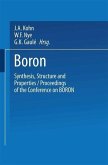This book is about compounds such as the boron hydrides and associated metal hydrides and alkyls which acquired the label 'electron deficient' when they were thought to contain too few valence electrons to hold together. Though they are now recognized as containing the numbers of bonding electrons appropriate for their structures, the term 'electron deficient' is still commonly applied to many substances that contain too few valence electrons to provide a pair for every pair of atoms close enough to be regarded as covalently bonded. The study of such substances has contributed much to chemistry. Techniques for the vacuum manipulation of volatile substances were devised specifically for their study; developments in valence theory resulted from considerations of their bonding; and the reactivity of several (for example, diborane and complex metal hydrides, lithium and aluminium alkyls) has made them valuable reagents. The purpose of this book is to provide an introduction to the chemistry of these fascinating compounds. The experimental and spectroscopic methods by which they can be studied are outlined, the various types of structure they adopt are described and profusely illustrated, and the relative merits of extended valence bond and simple molecular orbital treatments of their bonding are discussed, with as liberal use of diagrams and as limited recourse to the Greek alphabet as possible. A recurring theme is the importance attached to considerations of molecular sym metry. Their reactions are treated in sufficient detail to show whether these reflect any deficiency of electrons.
Dieser Download kann aus rechtlichen Gründen nur mit Rechnungsadresse in A, B, BG, CY, CZ, D, DK, EW, E, FIN, F, GR, HR, H, IRL, I, LT, L, LR, M, NL, PL, P, R, S, SLO, SK ausgeliefert werden.









